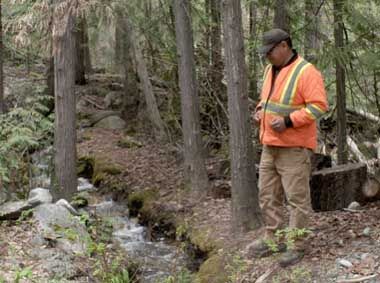Lytton-Nickeyeah Creek Water Treatment Plant
Case Study
Lytton First Nations
Nickeyeah Creek, BC, April, 2015
- UV/filtration/chlorination system
- Designed for ease-of-use
- Reduced chemical use
- Low cost for small user groups
The Lytton-Nickeyeah Creek water treatment plant is the result of a unique coming-together of a strategic network group (Natural Sciences and Engineering Research Council-NSERC, called RES’EAU-WaterNET), some pro-active First Nations treatment plant operators, and the design-manufacturer, with it’s most senior engineer, George Thorpe.
RES’EAU-WaterNET works closely with communities to understand the limitations and constraints they face. The ultimate goal is to produce integrated solutions that are effective for the community.
RES’EAU-WaterNET’s mobile water treatment pilot plant visited the site in Lytton and conducted tests on the source water as well as consulted with the community and the operators to both train and plan a system together that would be effective over the long term.
“It is important for the success of the project to have sufficient community input during the design phase,” says Madjid Mohensi, professor in the Department of Chemical and Biological Engineering at UBC and one of the lead researchers involved.
Jim Brown, maintenance manager and operation supervisor at Lytton First Nation organized the community input and fully collaborated with the RES’EAU team at various stages of the project.
“We require a cost-effective system that can handle our source water challenges, and one that can be operated reliably using the resources we have in the community”, said Brown. As part of the consultations, it was brought to light that residents disliked the unstable chlorine residual that resulted from changes in organic content of the source water.
“If I could drink out of a tap and it was good water I’d be saving millions,” Nickeyeah elder Ruby Dunstan had said in an interview while the pilot study was underway. She was buying many litres a week of bottled drinking water for her family since moving to the area about 20 years ago.
BI Pure Water and RES’EAU-WaterNET also worked closely with Aboriginal Affairs and Northern Development Canada (AANDC) during the plant’s design and rollout, in part to meet the budgetary requirements. A previous system quoted by a consulting engineering firm was deemed far too expensive, according to Brown.
In the winter of 2015 a water treatment plant was designed and built that the operators know how to maintain. It serves a remote community that has suffered from boil water advisories for many years.

The water treatment plant (WTP) is designed to make 19 L/min of water with a maximum day demand of 27 CUM/D (7,133 USG). The system uses pre-filtration, ultraviolet disinfection, and chlorine disinfection.
Pre-filtration is accomplished with up to six filter stages consisting of a basket strainer, self cleaning spin filters, bag filters, cartridge filters and activated carbon filter for removing the potential for chlorine byproducts. The filters require a simple changeout or cleaning occasionally when indicated by pressure indicators before and after each filter. The UV can be monitored by its controller and lamps changed out approx every year. Chlorine application is flow paced and conducted by an injection system. Just the tank levels and control panel need to be monitored.
At RES’EAU-WaterNET’s annual meeting Jim Brown presented P.Eng. George Thorpe with a symbolic gift of necklace, stating, “I am giving this to George because he’s the one that has managed to remove everything and make the water pure.”
BI Pure Water (BIPW) specializes in reviewing water quality test results and prescribing the most cost-effective solution. BIPW engineers pilot, design, manufacture, install, start-up and commission package water treatment plants. BIPW provides small and medium-sized water treatment plants for federal, provincial and municipal government, industry, remote camps, private water systems, resorts and First Nations communities.

